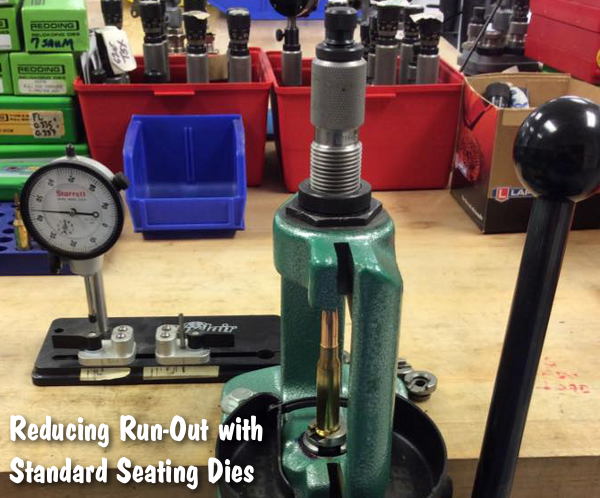How to Improve Case Concentricity with Standard Seating Dies

Each Wednesday, the U.S. Army Marksmanship Unit publishes a reloading “how-to” article on the USAMU Facebook page. This USAMU “Handloading Hump Day” article, the second in a series on improving concentricity, has many useful tips. If you use standard (non-micrometer) seating dies when loading some cartridge types, this article is worth reading. And visit the USAMU Facebook page next Wednesday for the next installment.

Once again, it’s time for USAMU’s “Handloading Hump-Day!” Last week, we addressed achieving very good loaded-cartridge concentricity (AKA “TIR”, or Total Indicator Runout) using standard, “hunting grade” reloading dies.
We explained how to set up the Full-Length Size die to float slightly when correctly adjusted for desired case headspace. We also cited a study in which this method loaded ammunition straighter than a set of [higher grade] match dies from the same maker. [One of the keys to reducing TIR with both sets of dies was using a rubber O-ring below the locking ring to allow the die to float slightly. READ Full-Length Sizing Die TIP HERE.]
Now, we’ll set up a standard seating die to minimize TIR — the other half of the two-die equation. As before, we’ll use a single-stage press since most new handloaders will have one. A high-quality runout gauge is essential for obtaining consistent, accurate results.
Having sized, primed and charged our brass, the next step is bullet seating. Many approaches are possible; one that works well follows. When setting up a standard seating die, insert a sized, trimmed case into the shell-holder and fully raise the press ram. Next, back the seating stem out and screw the die down until the internal crimping shoulder touches the case mouth.
Back the die out one-quarter turn from this setting to prevent cartridge crimping. Next, lower the press ram and remove the case. Place a piece of flat steel on the shellholder and carefully raise the ram. Place tension on the die bottom with the flat steel on the shellholder. This helps center the die in the press threads. Check this by gently moving the die until it is well-centered. Keeping light tension on the die via the press ram, secure the die lock ring.

If one were using a micrometer-type seating die, the next step would be simple: run a charged case with bullet on top into the die and screw the seating stem down to obtain correct cartridge OAL.
However, with standard dies, an additional step can be helpful. When the die has a loosely-threaded seating stem, set the correct seating depth but don’t tighten the stem’s lock nut. Leave a loaded cartridge fully raised into the die to center the seating stem. Then, secure the stem’s lock nut. Next, load sample cartridges and check them to verify good concentricity.
One can also experiment with variations such as letting the seating stem float slightly in the die to self-center, while keeping correct OAL. The runout gauge will show any effects of changes upon concentricity. However, the first method has produced excellent, practical results as evidenced by the experiment cited previously. These results (TIR Study 2) will reproduced below for the reader’s convenience.
| TIR Study 2: Standard vs. Match Seating Dies
50 rds of .308 Match Ammo loaded using carefully-adjusted standard dies, vs. 50 using expensive “Match” dies from the same maker. Standard dies, TIR: “Match” dies, TIR: AccurateShooter Comment: This shows that, with careful adjustment, the cheaper, standard dies achieved results that were as good (or better) than the more expensive “Match” Dies. |
These tips are intended to help shooters obtain the best results from inexpensive, standard loading dies. Especially when using cases previously fired in a concentric chamber, as was done above, top-quality match dies and brass can easily yield ammo with virtually *no* runout, given careful handloading.












 Redding has introduced a new series of Bullet Seating Micrometers (aka Micrometer Bullet Seater Plug Replacements). These can be retro-fitted into standard Redding seater dies with 1/2-20 thousandths threads, replacing the standard dies’ seater plugs. So, for about forty bucks, you can now make your standard Redding seater die into a Micrometer Seater — and you can swap one Micrometer Seater top among a variety of dies in the same caliber class (such as .223 to 22-250). Notably, the new Bullet Seating Micrometers are offered in two different configurations — one for traditional bullet shapes, and another for VLD bullets. Redding’s new Bullet Seating Micrometers are priced at $48.90 MSRP, but expect to see an initial “street price” of about $37.00-$39.00.
Redding has introduced a new series of Bullet Seating Micrometers (aka Micrometer Bullet Seater Plug Replacements). These can be retro-fitted into standard Redding seater dies with 1/2-20 thousandths threads, replacing the standard dies’ seater plugs. So, for about forty bucks, you can now make your standard Redding seater die into a Micrometer Seater — and you can swap one Micrometer Seater top among a variety of dies in the same caliber class (such as .223 to 22-250). Notably, the new Bullet Seating Micrometers are offered in two different configurations — one for traditional bullet shapes, and another for VLD bullets. Redding’s new Bullet Seating Micrometers are priced at $48.90 MSRP, but expect to see an initial “street price” of about $37.00-$39.00.





